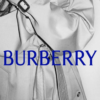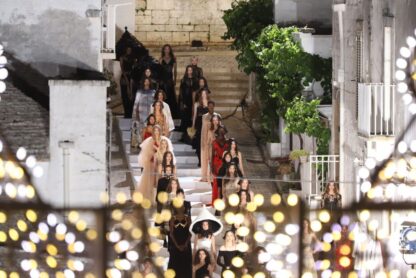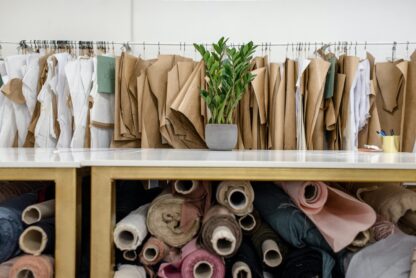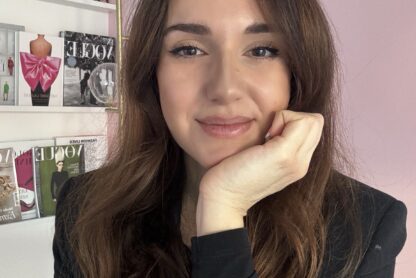Are you looking for the perfect career for you in fashion, and believe the role of a fashion merchandiser might be made for you? This role is often subject to many misinterpretations, so we’re here to explain it so you lose all the confusion.
The fashion merchandising field attracts both analytical and creative minds, those looking for the best of both worlds. Let’s dive into this exciting career, the common responsibilities, what skills are needed to succeed in this role, and how to become a fashion merchandiser.
The Role Of A Fashion Merchandiser And How To Become One
First, let’s break down the three main aspects of the role that often cause confusion.
First, a fashion merchandiser is not the same as a visual merchandiser; they are actually different roles and require a different set of skills. To explain it briefly, a visual merchandiser focuses solely on creating and maintaining any visual directives within a store from window displays to store layouts, while a fashion merchandiser does not take care of arranging window displays but participates in developing the collection and/or deciding which items will end up in stores.
Another confusion about the role is that it is the same as the role of a buyer. At some fashion brands, the two roles do work hand in hand and their names can be interchangeable; what one company may call a buyer, another calls a merchandiser. It can also happen that the responsibilities of a Buyer in Gucci might be the same as the Merchandising in Alexander McQueen, or that in smaller brands the two roles are merged into one as there is a smaller scale of product to work with. However, that is not always the case, and depending on the brand, a merchandiser’s tasks can be only partly similar to the ones of a buyer, or be totally different.
Fashion Merchandiser Job Description
Within the merchandising career, there are actually two variations of the job: there is a retail merchandiser and a collection merchandiser. Sometimes companies may add the component of “retail” or “collection” to the job title, or they may simply advertise it as “merchandiser”, so it’s important you know the difference and which one you prefer.
Collection Merchandiser
Although fashion is a creative industry, it is also a business and even design decisions need guidance based on numbers because the product has to sell. If the new collection has more pants than skirts, it’s not just a decision of the creative director or the design teams; it’s because the merchandisers have made their analysis of trends and past sales, and have determined that these are the categories to focus on for the next season in order to ensure profitability. They indeed build the collection grid with what the collection should include that they pass to the design team.
So the collection merchandiser works closely with the design team to develop the collection. Indeed, they need to be able to analyze past sales and trends while predicting what customers will want in the future, so they can create a collection plan that offers the guidelines of what needs to be included in the next collection to sell (more coats or dresses? what colors should be used for the collections?).
Other responsibilities of a collection merchandiser can include deciding price targets, reviewing garment samples, working with marketing and package design teams to develop marketing strategies, product messages and packaging, and providing regional teams with product knowledge.
Retail Merchandiser
A retail merchandiser is in fact the role that is often interchangeable with the role of a fashion buyer. That’s why if you want to work as a buyer, you should keep your eyes open on merchandising positions and vice versa. Read carefully the job description before applying so you’ll know exactly what to expect from that position and the responsibilities.
So, retail merchandisers intervene post the design process, and focus on ensuring the commercial and financial viability of a garment or product in-store, to make sure stock is flowing and is available where it will best sell, and the company makes maximum profitability. The collections must appear in the correct stores and brand’s websites at the right time in the correct amount, which retail merchandisers can achieve by using their forecasting skills and understanding of the consumer. For example, a retail merchandiser for Prada may be in charge of all stores across Europe and would need to understand the different Prada consumers’ needs from country to country or region to region to best coordinate where to place stock to maximize sales.
Overall, they forecast trends, plan stock levels then monitor its performance.
There are many tasks in retail merchandising, including defining calendars and strategies for the launch of upcoming collections and analyzing sales performances in different regions. They need to understand the customer of the physical stores or online stores they have been assigned to because although they may just be working at one company such as Chanel, the customer’s needs in Texas, US, and Milan, Italy might be different.
Retail merchandisers also have other responsibilities that include reviewing monthly reorder needs, defining product range and quantities, and communicating and working with suppliers and the product development team to ensure there are sufficient quantities of permanent products for your category in the network of stores you manage.
To conclude, both the collection merchandiser and the retail merchandiser heavily rely on trend forecasting and analyzing data to make informed decisions, however, the first focuses on the design process of garments and collections and the second focuses on the distribution of those collections.
What Does A Fashion Merchandiser Do
Although each day may be different based on new launches or busy periods, a merchandiser’s typical day and day-to-day tasks may look like this.
Whether you’re a collection or retail merchandiser, you will most likely start your day by analyzing sales and numbers. It’s important to keep track of your brand’s products and see what is performing best that week from the colors to product categories. You will need to make notes of your findings and update your team whether they are buyers or designers. As a collection merchandiser, the tasks may involve curating a list of what skirts would be the best fit for the new collection, whereas as a retail merchandiser, this task may include seeing what has been selling – or not selling – in the brand’s store.
Your mid-morning may begin with a team meeting, discussing with buyers or designers – or even both – about the new season’s range. You will be evaluating and analyzing emerging trends while showcasing your past data on sales to see what’s performing well.
Your post-lunch task could be getting to grips with the wider industry, noticing what competitors are doing, and what trends are arising. Your afternoon may then be spent catching up on emails and contacting suppliers. It’s crucial to keep a good relationship with all your suppliers and the international offices at your brand house.
To end your day, you may check stock levels. As a retail merchandiser, this may mean collectively recording your store’s sales and what items may need re-stocking. Whereas as a collection merchandiser, this could mean looking at fabric stock for the latest collection.
Fashion Merchandiser Skills
Having strong analytical skills is crucial for this role. You need to be able to understand and dive deep into sales figures. Every single merchandiser role requires excellent proficiency in Excel and PowerPoint to be able to analyze data and present it to your team. Excel is an absolute must-know, and we have great news for you! Our Excel for Fashion online course is perfect if you want to get this role and learn Excel applied to fashion. Click the link here to enroll.
Other important skills to have are:
- Being able to plan and prioritize your tasks to meet new launch deadlines.
- Having excellent communication and negotiation skills to engage with your team and suppliers.
- Express your vision and creativity. You need to be able to recognize what works best for your brand’s creative vision from a design or store consumer perspective.
- Decision making. Merchandisers need to be able to use their gut to decide what will be the latest trend and a good pick for their fashion brand for success.
- Fashion trend forecasting and analyzing trends – both upcoming and previous – is important to combine with sales research.
How To Become A Fashion Merchandiser?
What are the best studies to become a fashion merchandiser?
Many people go to fashion schools to get a degree in Fashion Merchandising. Design or Product Development are also popular options for those wishing to work as collection merchandisers. However, at Glam Observer we always say that you can land a fashion job with a more traditional degree as well. Many fashion merchandisers have a degree in economics, business, or finance, which can be especially useful if you want to specialize in Retail Merchandising. However, there isn’t a single rule. Some of my friends graduated in law and today work as buyers at Dolce & Gabbana and other major brands. Finally, since the results of purchasing the right products depend on understanding the consumer, you can apply confidently if you have a major in marketing.
If you are a student in a different field, that’s okay too, as long as you demonstrate a passion for the role and have the required skills.
If you still want to learn about fashion merchandising, you can take online courses focused on the fashion merchandising field or an online course about Excel or Trend Forecasting. Taking online courses will show your motivation and passion for the job and set you apart from other candidates.
How To Find Fashion Merchandising Jobs
The first two things you need to start doing if you want to find fashion merchandising jobs are:
1. learn Excel to become the perfect candidate for this role and
2. apply for merchandising internships at your favorite fashion brands or multi-brand stores and e-commerce such as Saks Fifth Avenue, Selfridges, Net-a-Porter, or Asos. As we saw, you can apply to merchandising internships even if your degree is totally unrelated. What recruiters care about most is knowing you are Excel savvy, as well as you have an analytical mindset and a passion for the fashion industry.
Fashion Merchandising Internships
The first thing you can do to look for fashion merchandising jobs or internships is to go to the official website of the fashion brand or Group to see if they have any open vacancies. Another option is LinkedIn, which is the most popular and best social media platform to look for fashion jobs.
At Glam Observer, we make the job search process easier by featuring the latest (merchandising) fashion jobs and internships every Friday in our 365 days of fashion newsletter. Click here to subscribe.
So these are the official ways to apply. But there is an unconventional strategy to get a merchandising job or internship: emailing the companies directly. See, you don’t want to waste time and opportunities by waiting for fashion brands to post buying jobs online. Be proactive and cold-email them instead and submit a spontaneous application with a strong resume and a customized cover letter. Companies love that; they appreciate people who think outside of the box.
I teach more about emailing companies directly as well as other unconventional strategies inside this free masterclass.
I hope that you have a clearer understanding by now of what a fashion merchandiser does. If it sounds like a dream career, start practicing the commonly required skills you might be lacking. Look for an internship at your favorite brand or retailer, and get prepared for an exciting career as a fashion merchandiser.










GOOD INFORMATION
Thanks for sharing this amazing piece of content with us. I would like to read more about the beauty products.
Thanks for information. It’s Very helpful
Great explanation about fashion merchandisers. thanks alots
Thank You For Such Valuable Information